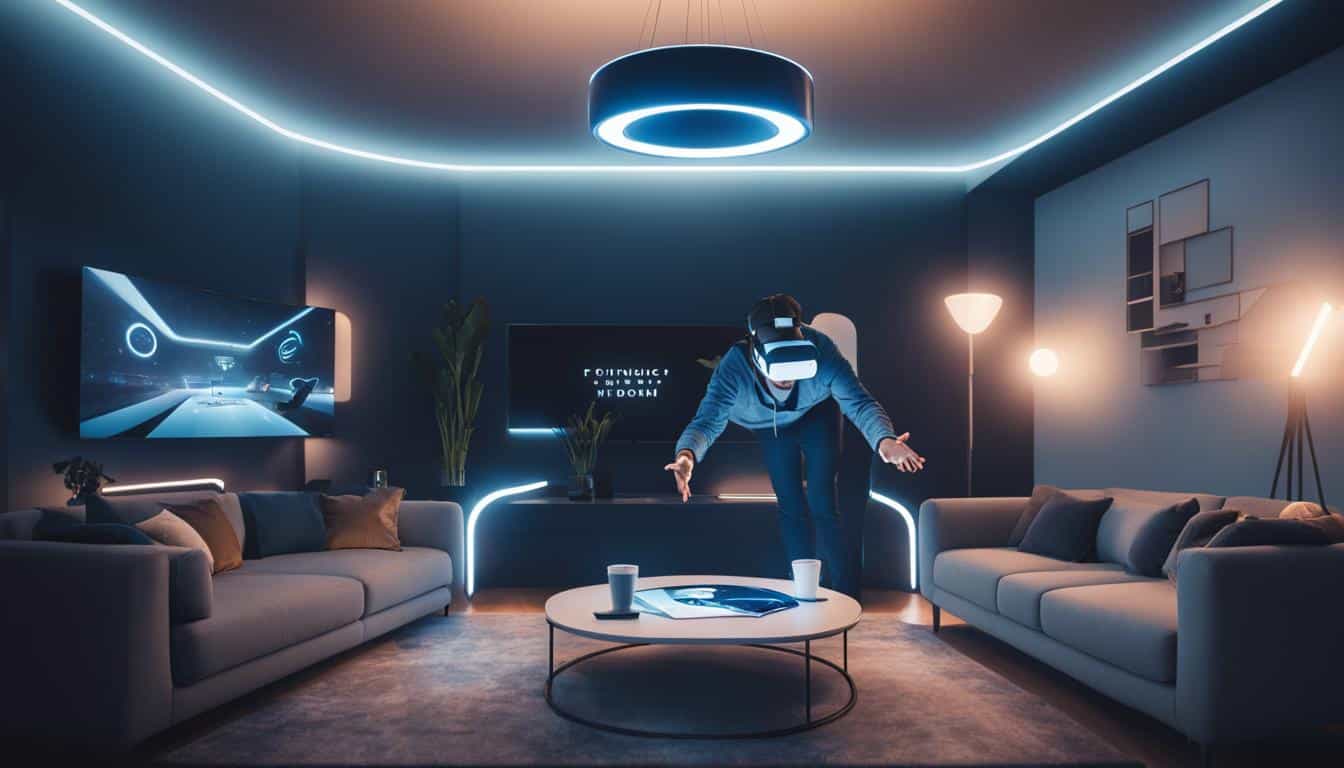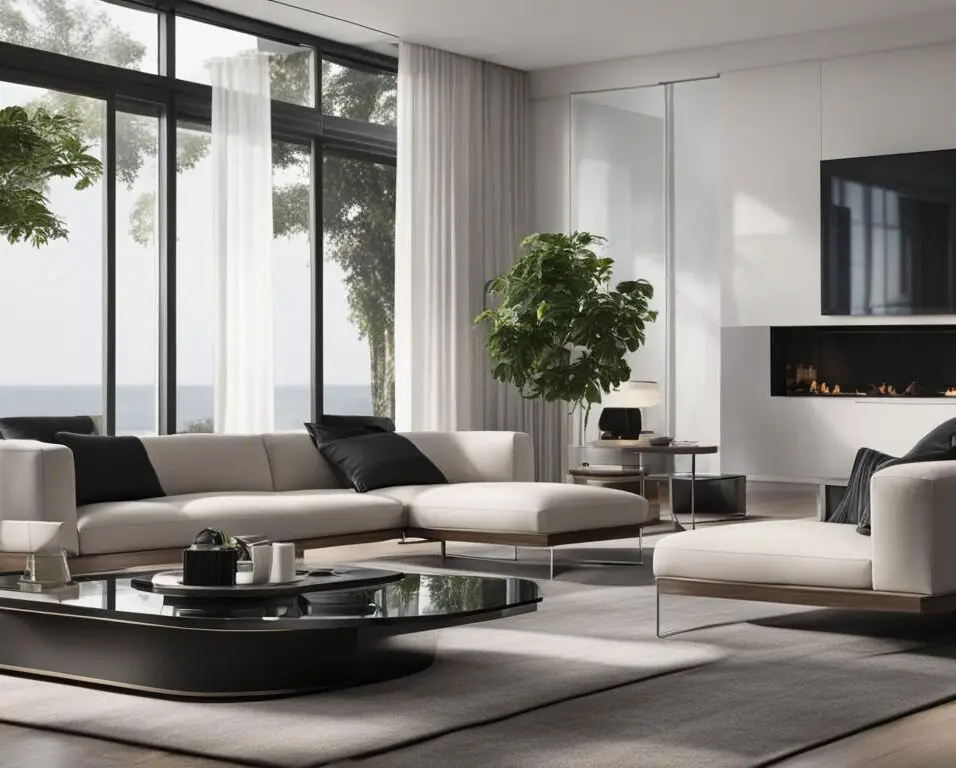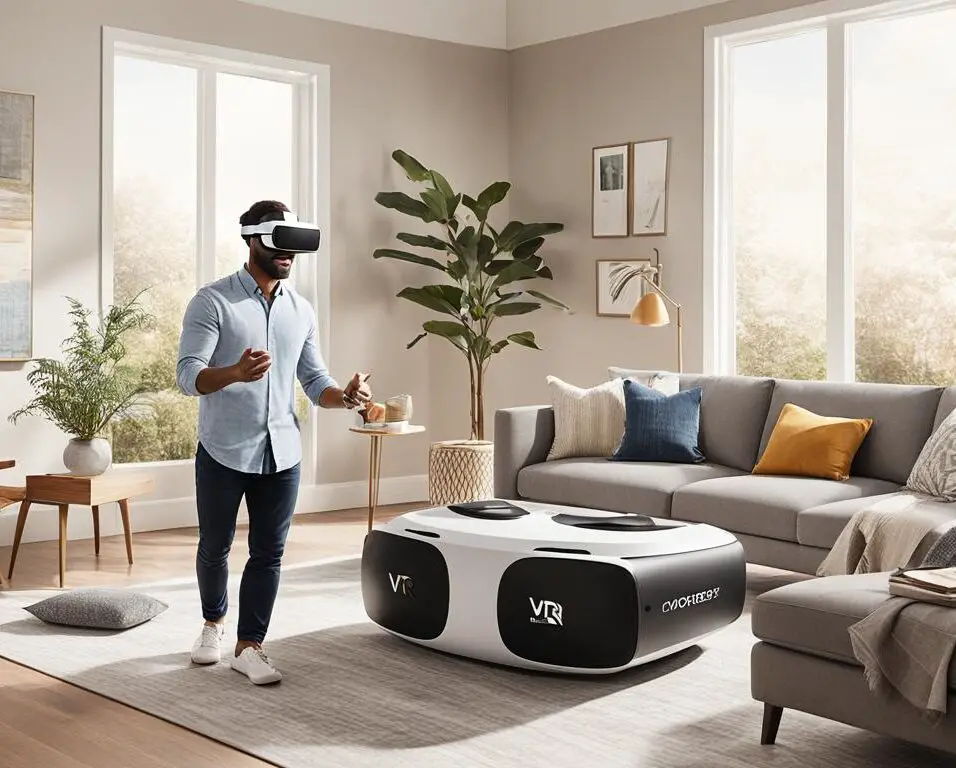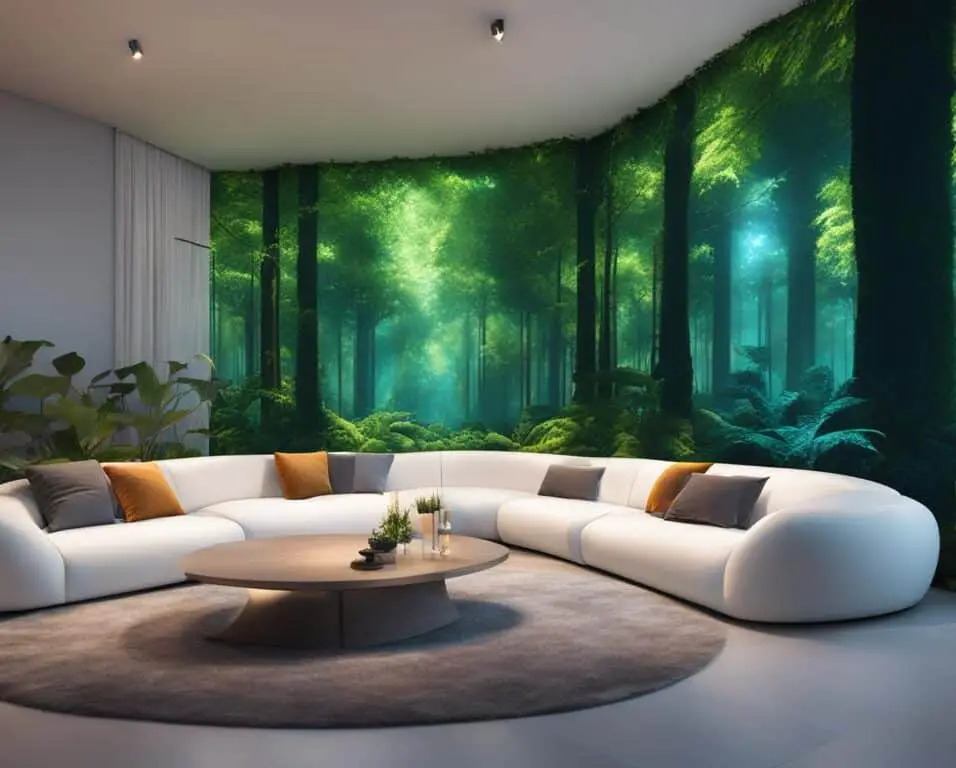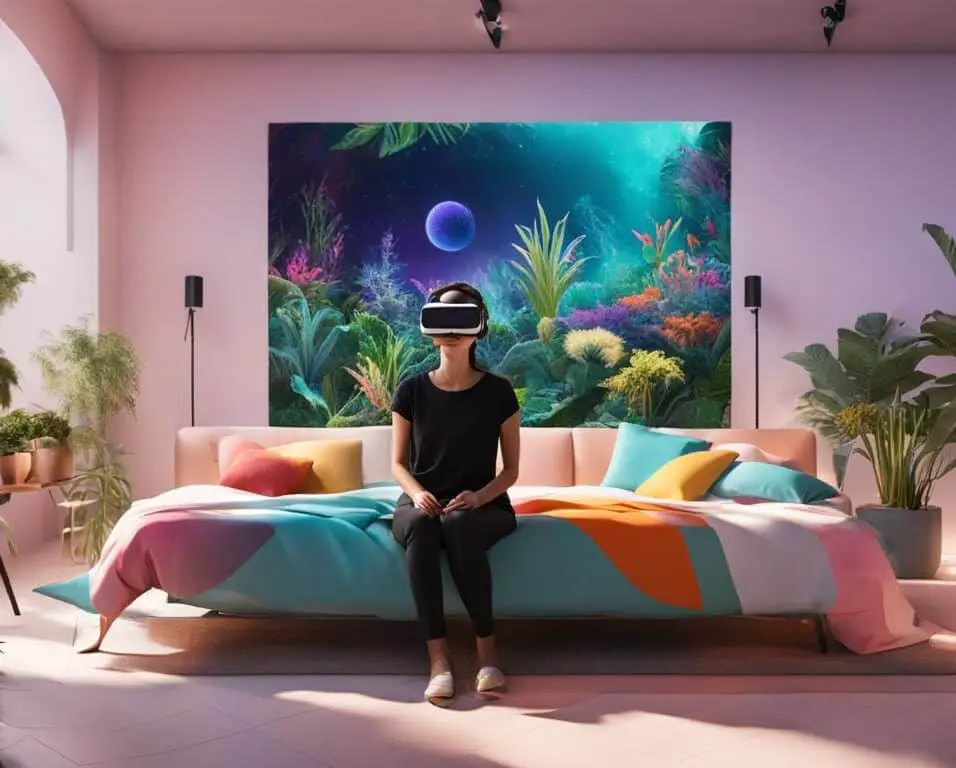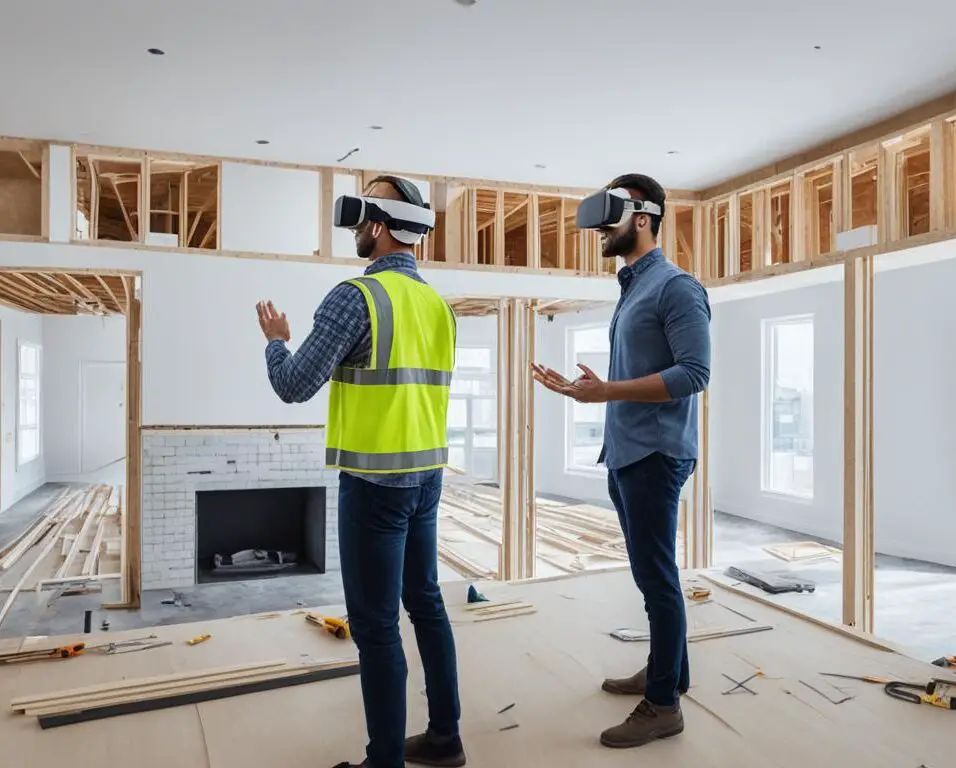Light Up Your World: VR Techniques for Home Lighting Design
Are you looking to transform the atmosphere of your home with stunning lighting design? Look no further! In this article, I will introduce you to the exciting world of VR techniques for home lighting design. With the use of virtual reality technology, you will be able to visualize and experiment with different lighting designs before making any changes to your actual space. Get ready to unleash your creativity and revolutionize the way you illuminate your home!
Key Takeaways:
- VR techniques allow homeowners to visualize and experiment with lighting designs virtually.
- Using VR in home lighting design saves time, money, and effort.
- Virtual reality tools provide an immersive experience and realistic representation of lighting designs.
- VR techniques enhance collaboration and communication between homeowners, designers, and contractors.
- The future of home lighting design is exciting with the continued advancement of VR techniques.
The Benefits of VR Techniques in Home Lighting Design
Using VR techniques in home lighting design offers several advantages. Firstly, it allows homeowners to visualize and experiment with different lighting options without having to physically install them. This saves time, money, and effort.
Secondly, VR techniques provide a realistic and immersive experience, enabling homeowners to truly understand the impact of different lighting designs on the ambiance and mood of their home. With VR, they can step into a virtual space and see how different lights and placements will affect the overall atmosphere.
Lastly, VR techniques allow for easy experimentation and customization. Homeowners can explore various lighting options, such as intensity, color, and placement, to find the perfect fit for their preferences and needs. This level of control and personalization is invaluable in creating a lighting design that truly reflects their style.
| Benefits of VR Techniques in Home Lighting Design |
|---|
| 1. Visualization and experimentation without physical installation |
| 2. Realistic and immersive experience |
| 3. Easy experimentation and customization |
Virtual Reality Tools for Home Lighting Design
In the world of home lighting design, virtual reality (VR) tools offer a groundbreaking approach to visualizing and experimenting with different lighting options. These tools, typically in the form of VR headsets or goggles, provide homeowners with an immersive experience, allowing them to explore and design their ideal lighting setups.
With VR tools, homeowners can enter a virtual environment and interact with lighting settings, adjusting intensity, color, and placement of lights. This enables them to see how different lighting designs would look and feel in their actual spaces, without the need for physical installations.
One of the key advantages of virtual reality tools is the ability to explore various design options before making any changes to the home’s lighting setup. By experiencing different lighting scenarios virtually, homeowners can make informed decisions about their design choices and ensure that every aspect of the lighting scheme is carefully considered.
Furthermore, some VR tools offer real-time rendering capabilities, allowing users to see immediate changes in lighting effects as adjustments are made. This feature provides instant feedback on the overall look and ambiance that different lighting designs can create in a space.
Virtual reality tools also provide an intuitive and user-friendly interface, making it easy for homeowners to navigate and experiment with different lighting options. The immersive nature of the VR experience enhances creativity and enables homeowners to unleash their imagination, resulting in unique and personalized lighting designs.
Advantages of Virtual Reality Tools for Home Lighting Design:
- Immersive experience: VR tools allow homeowners to step into a virtual environment and interact with lighting settings, providing a realistic preview of their lighting designs.
- Easy experimentation: Virtual reality tools enable homeowners to easily explore different lighting options and make adjustments in real-time, without the need for physical installations.
- Accurate visualization: With real-time rendering capabilities, users can instantly see how changes in lighting affect the overall look and feel of their space, ensuring accurate visualization of the final design.
- Enhanced creativity: The immersive nature of VR tools sparks creativity and enables homeowners to think outside the box when designing their lighting schemes.
- User-friendly interface: Virtual reality tools are designed to be intuitive and user-friendly, allowing homeowners to easily navigate and customize their lighting setups.
Overall, virtual reality tools revolutionize the home lighting design process by offering a dynamic and immersive platform for experimenting with different lighting options. With the ability to visualize and fine-tune lighting designs before implementation, homeowners can achieve stunning and customized lighting schemes that perfectly complement their spaces.
“Virtual reality tools empower homeowners to unlock their creativity and bring their lighting design visions to life in a realistic and immersive virtual environment.”
Designing Lighting Schemes with VR Techniques
When it comes to designing lighting schemes for your home, VR techniques offer an unparalleled level of creativity and precision. By leveraging the power of virtual reality, homeowners can create a virtual representation of their space and experiment with different lighting options within that virtual environment.
With VR techniques, you have complete control over every aspect of your lighting design. You can adjust the intensity, color, and placement of lights, ensuring that every corner of your space is perfectly illuminated. Additionally, VR allows you to simulate different natural lighting conditions, such as daylight or evening ambiance, giving you a realistic understanding of how your chosen lighting scheme will look and feel in real life.
One of the greatest advantages of using VR techniques for lighting design is the ability to see how various lighting elements interact with each other and with the surrounding decor and architecture. This allows you to make informed decisions about the placement and type of lights, ensuring that your lighting scheme complements your overall design aesthetic.
By using VR techniques for designing lighting schemes, homeowners can truly unleash their creativity and create a truly immersive and personalized lighting experience in their homes.
To illustrate the impact of VR techniques on lighting design, consider the example below:
| Traditional Lighting Design | VR-Enhanced Lighting Design |
|---|---|
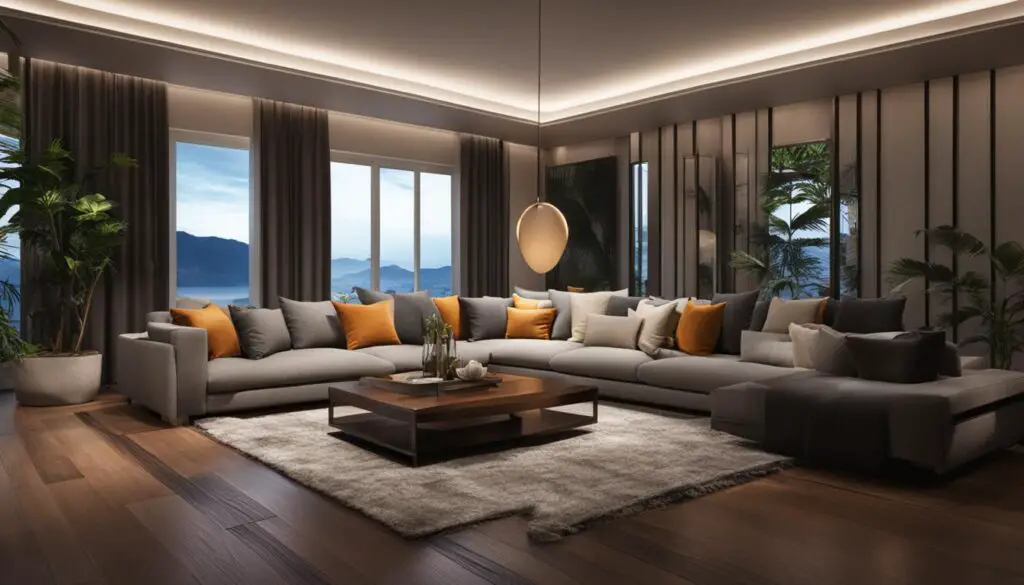 |
In the traditional lighting design approach, homeowners rely on their imagination and limited renderings to visualize how their lighting scheme will appear. There’s always a degree of uncertainty and room for error. However, with VR-enhanced lighting design, homeowners can step into a virtual environment and experience their lighting scheme firsthand. This immersive experience provides a deeper understanding of the impact of different lighting choices and allows for adjustments to be made before any physical changes are implemented.
Using VR techniques for designing lighting schemes not only ensures that every aspect of your space is beautifully illuminated but also saves time and resources by eliminating the need for costly and time-consuming trial and error installations.
So whether you’re looking to create a cozy, ambient atmosphere in your living room or a bright, energizing workspace in your home office, VR techniques can empower you to design and visualize the perfect lighting scheme.
Enhancing the Home Lighting Design Process with VR Techniques
When it comes to home lighting design, VR techniques offer a multitude of benefits that enhance the overall process. By harnessing the power of virtual reality, homeowners can achieve a more accurate and realistic representation of their final lighting design, making informed decisions with confidence.
One of the key advantages of VR techniques is their ability to facilitate collaboration and communication among homeowners, designers, and contractors. Virtual environments can be easily shared and discussed, allowing for a streamlined and efficient design process. With everyone on the same page, the vision for the lighting design becomes clearer and the implementation smoother.
Not only does VR enhance collaboration, but it also saves time and resources. With VR, there’s no need for physical prototypes or trial-and-error installations. Homeowners can experiment with different lighting designs virtually, reducing costs and minimizing waste. This not only benefits the environment but also the budget.
Let’s delve deeper into the advantages of enhancing the home lighting design process with VR techniques:
A More Accurate and Realistic Representation
VR techniques provide homeowners with a true-to-life simulation of their lighting design, ensuring that it accurately reflects the final result. By immersing themselves in a virtual environment, homeowners can experience how different lighting options will look and feel in their space. This eliminates the risk of design errors and ensures that the chosen lighting design aligns with their vision.
Enhanced Collaboration and Communication
With VR techniques, collaboration and communication become seamless. Homeowners can easily share their virtual environments with designers and contractors, who can then contribute their insights and suggestions. Discussions can take place in real-time, allowing for efficient communication and ensuring that everyone is on the same page. This collaborative approach leads to a more cohesive and successful lighting design.
Savings in Time and Resources
The use of VR techniques eliminates the need for physical prototypes and costly trial-and-error installations. Homeowners can experiment with various lighting designs virtually, saving both time and money. This efficient process allows for quick iterations and adjustments, resulting in a final lighting design that meets the desired aesthetic and functional requirements.
Overall, VR techniques are a game-changer in the home lighting design process. By providing a realistic representation, facilitating collaboration, and saving time and resources, VR techniques empower homeowners to achieve their dream lighting designs with confidence and ease.
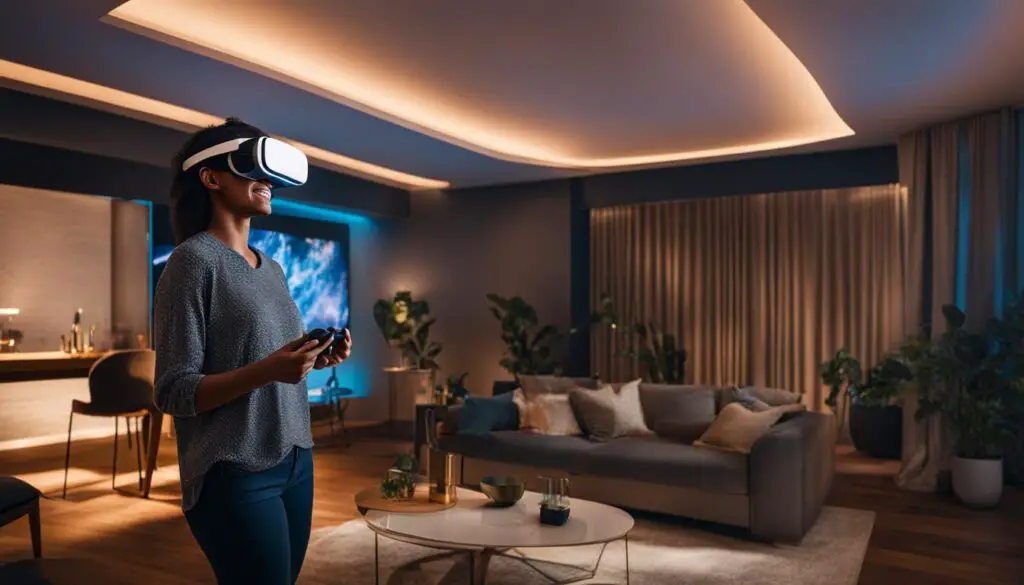
The Future of Home Lighting Design: VR Techniques
The future of home lighting design shines bright with the continued advancement of VR techniques. As technology evolves, VR tools will become more accessible and affordable, allowing an increasing number of homeowners to harness the power of these innovative design methods. The integration of VR with other smart home technologies, such as voice-controlled lighting systems, will further elevate the overall home lighting experience.
With VR techniques at the forefront, homeowners will be able to push the boundaries of creativity and bring their lighting visions to life. The ability to immerse oneself in a virtual environment and explore different lighting designs provides unparalleled opportunities for experimentation and customization. No longer limited by traditional design constraints, individuals can create personalized and stunning lighting schemes that perfectly suit their unique preferences and needs.
But the future of home lighting design doesn’t stop there. VR techniques are poised to revolutionize the way we interact with and control our lighting systems. With the seamless integration of VR and voice-controlled lighting systems, homeowners can adjust the ambiance and brightness levels with a simple command. This convergence of technologies not only enhances convenience but also opens up new avenues for creativity, enabling homeowners to set the perfect mood for any occasion effortlessly.
The Role of VR in Home Lighting Design
Virtual reality has already demonstrated its transformative power in various industries, and home lighting design is no exception. By providing a virtual platform for experimentation and visualization, VR techniques hold immense potential for elevating the design process and outcomes. The ability to create immersive simulations allows homeowners to see their lighting designs in action before committing to any physical changes.
VR techniques enable users to:
- Experience a realistic representation of their future lighting design.
- Test different lighting options and configurations.
- Visualize the impact of lighting on the overall atmosphere and aesthetics of their space.
- Identify any potential issues or areas for improvement.
- Collaborate and communicate effectively with designers, contractors, and other stakeholders.
VR techniques empower homeowners to make informed decisions about their lighting designs, ensuring that every aspect of their space is beautifully illuminated.
The possibilities offered by VR techniques in home lighting design are truly exciting. As technology continues to evolve, these innovative tools will become more refined, accurate, and user-friendly, making them accessible to a wider audience. The future of home lighting design is brighter than ever, with VR techniques paving the way for personalized and breathtaking lighting experiences in every home.
Case Studies: Successful Implementation of VR Techniques in Home Lighting Design
Several case studies have demonstrated the effectiveness of VR techniques in home lighting design, showcasing their ability to transform the design process and enhance overall outcomes. These studies provide real-world examples of homeowners who have successfully utilized VR tools and simulations to create more efficient and accurate lighting design solutions, resulting in increased satisfaction and a greater sense of control over their living spaces.
“Using VR techniques allowed me to visualize different lighting options in my home before making any changes. It gave me the confidence to experiment and customize my design, resulting in a truly personalized lighting scheme that perfectly suits my preferences.” – Sarah Thompson, homeowner
Through these case studies, it becomes evident that VR techniques offer significant advantages in home lighting design. By providing a realistic and immersive experience, homeowners can make well-informed decisions about lighting choices, ensuring that every aspect of their space is beautifully illuminated. Let’s take a closer look at some exemplary case studies:
Case Study 1: The Reynolds Residence
The Reynolds residence is a prime example of how VR techniques can revolutionize home lighting design. Mr. and Mrs. Reynolds wanted to create a cozy and inviting ambiance throughout their spacious living area while ensuring ample task lighting in their kitchen and study. By utilizing VR tools, they were able to experiment with various lighting options, adjust different settings, and evaluate the impact of natural lighting conditions on their design. The VR simulations allowed them to achieve the perfect balance of lighting for each area within their home, resulting in a remarkable transformation.
Case Study 2: The Patel Apartment
The Patel apartment showcases the power of VR techniques in small-space lighting design. As a young couple living in a compact urban apartment, Mr. and Mrs. Patel wanted to optimize their limited space while maintaining a modern and stylish aesthetic. With VR tools, they were able to explore different lighting options and experiment with color temperatures, intensities, and placement. Through these simulations, the Patels were able to maximize natural lighting and strategically incorporate artificial lighting to visually expand their living area. The end result was a visually stunning lighting design that surpassed their expectations.
Case Study 3: The Garcia Family Home
The Garcia family home exemplifies the collaborative nature of VR techniques in home lighting design. The Garcias desired a lighting scheme that would accommodate their diverse activities and preferences, while also considering the needs of their children. By using VR tools, they were able to share and discuss design ideas with their lighting designer, ensuring effective communication and mutual understanding. VR simulations allowed the Garcias to see different lighting scenarios and make informed decisions as a family. This collaborative approach resulted in a lighting design that enhances their daily activities and fosters a sense of unity within their home.
| Advantages of VR Techniques in Home Lighting Design | Case Studies | Notable Outcomes |
|---|---|---|
| Visualize and experiment with different lighting designs | The Reynolds Residence | Crafting a cozy and inviting ambiance |
| Make well-informed decisions about lighting choices | The Patel Apartment | Optimizing limited space and achieving a modern aesthetic |
| Facilitate collaboration and effective communication | The Garcia Family Home | Promoting unity and accommodating diverse needs |
These case studies highlight the transformative power of VR techniques in home lighting design. By leveraging the advantages of virtual reality tools, homeowners can create lighting schemes that not only meet their aesthetic preferences but also enhance their overall living experiences. The successful implementation of VR techniques in these case studies serves as a testament to the immense value they bring to the field of home lighting design.
Conclusion
VR techniques have the potential to revolutionize the way we approach home lighting design. By providing realistic and immersive experiences, allowing for easy experimentation and customization, and enhancing collaboration and communication, VR techniques empower homeowners to create stunning and personalized lighting designs.
With VR technology, homeowners can now visualize and experiment with different lighting designs before making any changes to their actual spaces. This opens up a world of possibilities, enabling greater creativity and precision in home lighting design.
As technology continues to advance, the future of home lighting design looks even more promising with VR at the forefront. With the integration of VR with other smart home technologies, homeowners can create personalized and stunning lighting designs that truly transform their living spaces. So, embrace the power of VR techniques and light up your world with innovative home lighting designs.
FAQ
How can VR techniques revolutionize home lighting design?
By utilizing virtual reality technology, homeowners can visualize and experiment with different lighting designs before making any changes to their actual spaces, allowing for greater creativity and precision in home lighting design.
What are the advantages of using VR techniques in home lighting design?
VR techniques allow homeowners to see how different lighting options would look in their space without physically installing them. It provides a realistic and immersive experience, enabling homeowners to understand the impact of different lighting designs on the ambiance and mood of their home. VR techniques also allow for easy experimentation and customization, giving homeowners the freedom to explore various lighting options.
What virtual reality tools are available for home lighting design?
Virtual reality tools typically consist of VR headsets or goggles that allow users to immerse themselves in a virtual environment. Users can interact with the virtual space, change lighting settings, and explore different design options. Some virtual reality tools also offer additional features such as real-time rendering, which allows users to see how changes in lighting would affect the overall look of their space instantaneously.
How does designing lighting schemes with VR techniques work?
Designing lighting schemes with VR techniques involves creating a virtual representation of the space and experimenting with different lighting options within that virtual environment. Homeowners can adjust the intensity, color, and placement of lights, as well as simulate different natural lighting conditions. This allows them to see how various lighting elements interact with each other and with the surrounding decor and architecture.
How do VR techniques enhance the home lighting design process?
VR techniques provide a more accurate and realistic representation of how the final lighting design will look, reducing the risk of design errors. They also facilitate collaboration and communication between homeowners, designers, and contractors, as virtual environments can be easily shared and discussed. VR techniques save time and resources by eliminating the need for physical prototypes and trial-and-error installations.
What is the future of home lighting design with VR techniques?
With the continued advancement of VR techniques, VR tools will become more accessible and affordable, allowing more homeowners to take advantage of these innovative design methods. The integration of VR with other smart home technologies, such as voice-controlled lighting systems, will further enhance the overall home lighting experience.
Are there any case studies on the successful implementation of VR techniques in home lighting design?
Yes, several case studies have shown that using VR tools and simulations significantly improves the overall design process, resulting in more efficient and accurate lighting design solutions. Homeowners have reported increased satisfaction with their lighting designs and a greater sense of control over their living spaces.
How can VR techniques revolutionize home lighting design?
By providing realistic and immersive experiences, allowing for easy experimentation and customization, and enhancing collaboration and communication, VR techniques empower homeowners to create stunning and personalized lighting designs.
Source Links
- https://robots.net/computing-and-gadgets/wearables/how-to-set-up-runmus-gaming-headset-led/
- https://www.digitalcameraworld.com/news/sony-could-abolish-the-a7s-line-in-favor-of-the-compact-fx3-ii
- https://robots.net/gaming-and-entertainment/pc-gaming/how-to-make-a-game-controller-in-adobe-illustrator/



